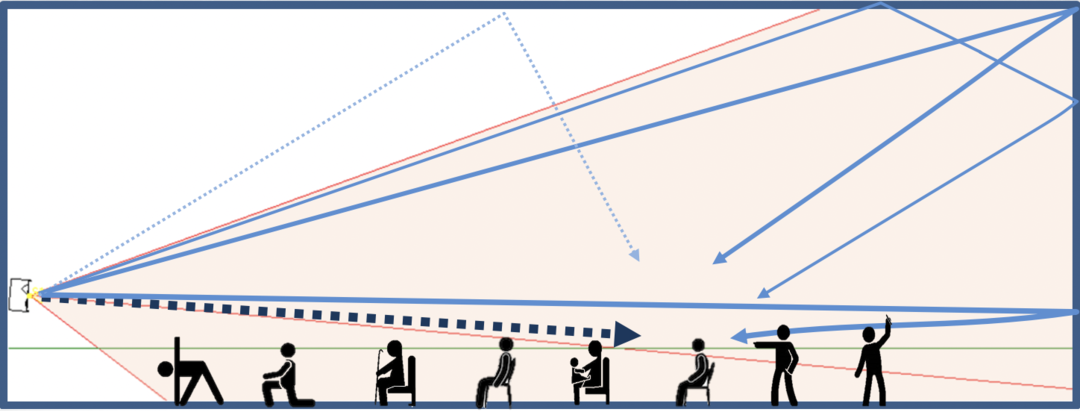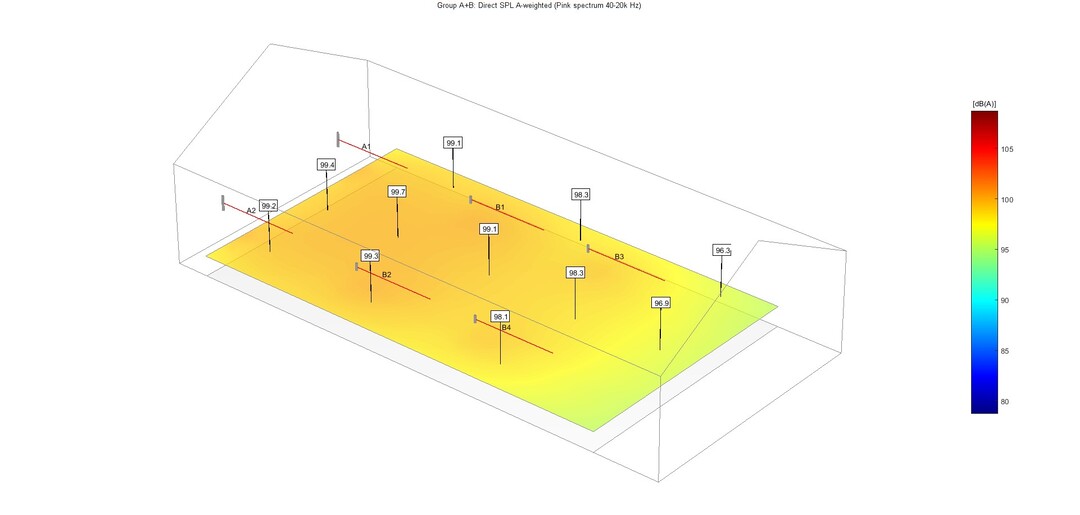
Since its inception 10 years ago, JBL’s CBT (Constant Beamwidth Technology) range of column loudspeakers have been a workhorse for the pro audio and AV install industry. For the Applications Team here at Sound Technology, the CBTs offer a multi-tool approach to many different scenarios and are a regular on our specifications. Especially for installations in tricky acoustic spaces, CBT's are supremely flexible problem-solvers with highly impressive full-range audio quality to match.
For anyone who doesn’t know, we have a demo room at our facility in Hertfordshire; this is a large acoustically treated warehouse space hosting everything from product from our install range right up to the VTX tour sound rigs, and we host regular demonstrations as well as onsite training. What I have found hosting these is that the CBT series is one of the major talking points.
Demonstrating just how useful these are and getting people thinking about how they can use them in their projects/installs is one of the parts of the job I enjoy most, seeing the penny drop when you demonstrate the differences between the more speech-focused models and the performance models of the range always makes me smile and I can pretty confidently say that we have driven many unexpected sales from these demonstrations.
So to get to the point, what are CBT speakers? What can they do? What’s so special about them over other speakers? Why do you guys like them so much? Where can I buy some? Just take my money...
We’ll get to that...
The primary purpose of the JBL CBT Series is to overcome the challenges of highly reflective or reverberant acoustic environments by directing sound precisely to the audience.
Conventional loudspeakers typically have a wider coverage pattern with limited mid and low frequency control. This results in sound reflecting off room boundaries, delivering to the listener direct sound from the speaker itself plus any number of unwanted reflections. The differing arrival times of these reflections create a lack of clarity for the listener, a reduction in intelligibility.

Image: Conventional speakers create unwanted reflections off boundary walls, severely impacting the clarity of sound reaching the audience.

Image: Highly directional speakers, such as the JBL CBT Series, dramatically increase the intelligibility of the audio reaching the audience by targeting sound only where you want it.
Furthermore, conventional loudspeakers have a significant drop-off in loudness (SPL) over distance, thus front-to-back coverage of a venue is not consistent.
The JBL CBT Series solves these issues. Here's how ...
CBT stands for Constant Beamwidth Technology - a patented technology from JBL that allows for pattern control consistency by using complex analogue delay and amplitude-tapering to create beams of sound with consistent vertical coverage, without the narrow vertical beaming and out-of-coverage lobing that are typical of other straight form-factor column speakers ...
To simplify; the units are passive column speakers consisting of multiple drivers in a vertical line, this creates a narrow vertical beam of sound.

CBT is a true line-array design, i.e. when multiple drivers are spaced correctly, certain frequencies couple together, creating a single ‘beam’ of sound. This differs to your usual point source speaker which radiates out in all directions. Take the example of dropping a pebble into a pool of water. A point source driver is your single pebble rippling out in all directions; you drop two pebbles equally spaced and the ripples clash, creating both positive and negative interference and start to form a flat, forward wavefront ... 3 pebbles, 4 pebbles...
What’s important here is that we are using this interference to shape and direct the speaker’s sound. What the researchers at JBL found was that when you curve an array of speakers you get a delay and that delay helps further shape the beam as well as preventing some of the lobing issues (spikes of sound where we don’t want them) that straight columns suffer from.
The main issue now was the size and depth of these speakers wasn’t practical for install. The solution was to delay each driver in the circuitry to create a ‘virtual curve’. This is accomplished by having the central pair as point zero, you then step out to the next pair (above and below) and add a slight delay and a little bit of attenuation (calculated from the curve), then you keep stepping out. This is all done passively in the box, so no additional DSP costs; any amp that meets the power requirements will do the job.
The result is the CBT speaker: a shallow, slim column that is very sensitive visually and architecturally but offers powerful, highly articulate, full-range sound with wide horizontal, and narrow, focused vertical dispersion. The range is also IP-55 rated when used with an input panel cover, making them suitable for outdoor install.
The other major benefit is the effect of line-arrays on loss of level over distance. There’s a physics rule called the Inverse Square Law, this states that for every doubling of distance there is a halving of power; for point source speakers this is true, that halving of power being a -6dB drop.
With line-arrays and columns you actually find the drop over the nearfield halves, so you see a -3dB loss over the same distance. What this gives you is consistency of sound. Walking the room with the CBTs on, you will notice very little variation in level from the front right to the back, obviously this is a huge selling point for speech and music.
I’ve just scratched the surface of the technical brilliance behind these speakers, but our colleagues at Harman are currently hosting regular online deep-dive training presentations on many of the JBL lines, including CBT. Check out the Harman University site for more detail on these.
So that’s all well and good, but what are the applications?
In short, CBT speakers are fantastic for challenging acoustic spaces, places where you want to keep sound focused on the audience and avoid unwanted reflections from hard walls or ceilings that can seriously degrade intelligibility. Churches, cathedrals, lecture theatres, modern glass-riddled acoustical nightmares ... this is where the CBT series really shines. But they are also perfect for any situation where discrete, multi-purpose and high-fidelity audio is required.
Here are a just a few case studies of CBT in use:

JBL start the range with the CBT 50 and the CBT 100 which are primarily focused on speech reinforcement but with low-end reinforcement make capable music systems. These are 8 and 16 driver units that can be run passively (8 ohms) or 100v line (60w/120w). Both units have passive EQs focused on speech and music which can be selected using a rotary switch on the unit and the CBT 100 has a selectable dispersion for broad and narrow vertical coverage patterns (40 and 15 degrees). The CBT 50 and 100 were later put forward for life safety certification and the CBT 50–LS and CBT 100-LS versions can be used in EN54 applications.

The CBT 200 was introduced next and retains the narrow form-factor of the original 50 and 100 models, but increases the throw-lengths achievable and offers extra beam-shaping features to better tailor it to the acoustic environment in big spaces.

Next is the CBT 70J-1, which uses the same concepts and technology but with a focus on music reproduction. These are J-arrays and the delays in the network aren’t quite equal so it has a slight natural down-tilt and front fill pattern, making it suitable for suspending higher or flying. The CBT 70s also have 5” Low Frequency drivers behind the HF drivers and an option for the CBT 70-JE bass extension, adding an additional 4 x 5” LF Drivers and extending the array length (which gives better directional control of lower frequencies).
The audio performance step from CBT 100s to 70s is considerable... the price tag isn’t... this is the up-spec I see most in our demo facility, people find the extra budget for the improved low-end performance of the 70s.

With the CBT 70s being a very successful product, JBL were seeing more and more being specified into conference space (16 - 30m) with larger spaces adding delayed fill speakers, then more delays and so on... It reached a point where the market needed something bigger. Enter the CBT 1000 and 1000E bass units. When the CBT1000 arrived with us it put a huge smile on our faces and made us re-think what we consider ‘performance PA’ to be.
In its full format (with extension) the system can handle a continuous input of 2400w AES (yes really!), and can output similar SPL levels to multiple units from our mid-range tour-sound arrays. Its epic performance, impressive throw lengths (25-54m – depending on settings) and wide range of different vertical beam settings has now provided us with a solution for venues where previously the option was always some form of compromise between performance and directivity.
There are many acoustically challenging but architecturally beautiful spaces where from one day to the next they could be hosting a spoken word act, a small jazz ensemble, live bands, DJs or even a community cinema event. Now CBT1000 will do it all, without compromise. We have seen them specified into clubs in Ibiza as well as large conference venues as an alternative to traditional line-array boxes. When accompanied with a suitable sub the punch you get from the CBT1000s has to be heard...
Using JBL's free DDA (Digital Directivity Analysis) software and CBT Calculator software, the acoustic coverage that will be provided by a CBT system can be easily modelled for any space. These three examples below, with screenshots taken directly from the software, show a typical lecture theatre example using a pair of CBT70J/JE, a church using a pair of CBT100 with two pairs of CBT50 delays, and a theatre using a pair of CBT1000 with CBT1000E bass extenders.
In this typical lecture theatre example, just a pair of CBT70J with CBT70JE bass extenders provide even coverage across the whole frequency spectrum to every seat in the raked audience.


A distributed system consisting of a pair of CBT100 with four CBT50s acting as delays provide consistent coverage to a typical church application.


In this example, a single pair of CBT1000 with CBT1000E bass extenders provides even coverage to a theatre space including a 2nd tier of seating.


Our demo facility in Hertfordshire houses the full CBT range and stacks of other fantastic speakers to pair with them. As soon as we are able this will re-open (we are hoping this could be August, subject to all relevant safety measures), allowing you to come and look at system design options and hear it in action for yourself.
In the meantime, for any further information please contact us here at Sound Technology's Application Team or by calling 01462 480000.